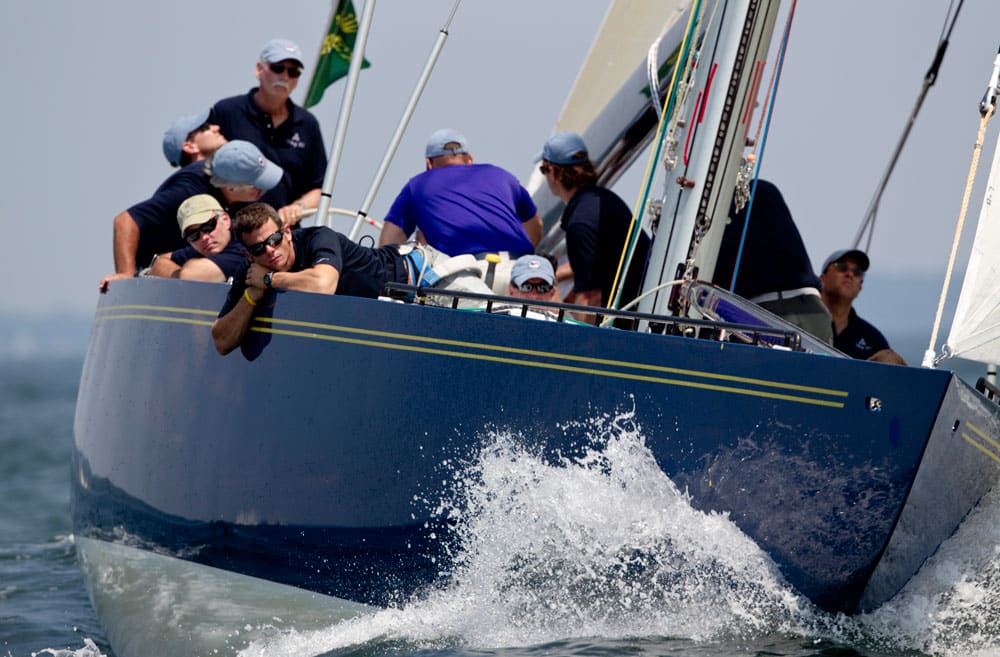
110728_Victory83
**The New York Yacht Club’s Annual Regatta is always as much spectacle as it is a regatta. **Really, how many other weekend regattas have a Volvo 70 entered in IRC? This year, the event’s boat porn quotient was even higher than normal with the approaching starts of the Transatlantic Challenge and J Class Regattas. Walking the piers of Newport Shipyard, you were treated to the enormous, odd, yet strangely beautiful Maltese Falcon, the VO 70 on steroids Rambler 100, her archrival ICAP Leopard, the stunningly beautiful J Class Velsheda, Puma’s Mar Mastro, and a collection of the hottest racing boats on the East Coast. (If you missed the spectacle, check out the US SAILING Roadshow blog at ussroadshow.blogspot.com for a video tour). If you walked a little further down the pier, though, you entered a time warp. Nestled amongst the carbon behemoths were the 12-Metres, ghosts from the day when the America’s Cup was really Newport’s Cup. The Cup is long gone. The 12s, which have graced the waters of Newport for 50 years, show no signs of going away anytime soon.
With a length of approximately 70 feet, and a whopping displacement of approximately 60,000 pounds, the 12-Metres have been lovingly referred to as, “The world’s most expensive way to sail at 8 knots.” Everything about these boats is big and heavy. If you need to do a headsail change, bring friends; the genoas weigh in at close to 85 pounds each. (Yes, that’s an aramid sail. I feel really bad for the crews on the 12-Metres in the Traditional Division, who are stuck with Dacron cloth!) As a jib trimmer on the modern 12-Metre Victory 83, I was immune from hauling jibs around that week. Instead, I just needed to worry about a jib sheet with 15,000 pounds of load wrapping around my waist and cutting me in half. With wind speeds hovering in the upper teens for the regatta, a misstep could’ve led to serious injury. I tried to keep that thought out of my mind as I asked for the backstay to be tightened over 12,000 pounds.
The 12-Metres were used in the Americas Cup from 1958 to 1987. When the Cup came out of retirement after the wars, this class was seen as a cost-sensitive alternative to the J Class yachts of the 1930s. Since it was also based on the internationally popular International Rule, global support for the class was also present. 12-Metres were built to Lloyd’s standards, a main reason why so many hulls are still sailing. (Does anyone really expect to see any IACC yachts sailing in 5 years, let alone 50 years from now?) Newport became home to the 12s, and many of the historically significant yachts still sail regularly. Intrepid defended the Cup twice and was a critical component to four Cup campaigns. Ted Turner’s Courageous still patrols the waters off Newport, and is still very fast. Even New Zealand’s “plastic fantastics” from the 1987 America’s Cup in Perth are here. The first fiberglass 12s caused Dennis Conner to say during a press conference: “The last 20 12-Metres have all been built from aluminum, why would you build one from fiberglass unless you want to cheat?” Even after they were dropped from the Cup, the 12s played a starring role in the movie Wind.
While the yachts are pieces of history, it’s the crews that make sailing on a 12-Metre worthwhile. I remember watching the 1987 Americas Cup on TV as a kid. Many of the guys who were crewing the 12s then are still crewing the 12s now. Their stories and camaraderie drive the yacht club time machine. Every time I sail on a 12, I feel like a kid living out his dream of waking up as a member of his favorite sports team.** I’ve heard what it felt like to be part of the crew of Australia II when they finally defeated the New York Yacht Club in 1983 so many times that I feel like I was there**. Their stories have become our stories, and the good old days have never ended. Last fall, the 12-Metre legends gathered in Newport for a reunion coinciding with the North Americans. There I was, sailing with and against the likes of Ted Turner, Dennis Conner, Russell Coutts and Gary Jobson, to name but a few. It was 1983 again, just without the big hair and short shorts.
Back to reality. The Race Committee has given us two 6-leg, short-track races in a row on a windy day. Things were happening fast, even on a 12-Metre. There was a constant spray of water in my face as we pounded through short Narragansett Bay chop. We managed to push Intrepid to the other side of the course and there was one final cross before the mark. Victory tacked with a series of creaks and groans as the sheets unloaded. Grinders toiled to bring in the big genoa one last time. We rounded ahead of the fleet again and hoisted the big symmetrical spinnaker for the final run to the finish. (No Wind fans, we don’t have a sail called a “whomper”) The pole was squared back and Victory pushed away the sea at 8.5 knots. As long as we didn’t screw up, the regatta was won. And then it was all over. I stepped off the yacht club time machine and back into the present. But for that weekend, I really enjoyed living in the past.









